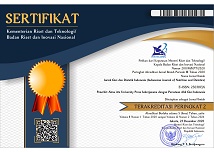Development of low sodium salted eggs and its antioxidant potential
Abstract
ABSTRACT
Background: Salted egg is one of processed egg products which has a nutrient content that is comparable to the fresh egg, has a longer shelf life and can be consumed by all ages. The main process in the salted egg production is salting (NaCl) treatment that will give salty taste and acts as a preservative.
Objectives: This study aimed to develop low-sodium salted eggs with an antioxidant potential through the innovations in the salting process.
Methods: This was an experimental research. Salted eggs were produced with innovations in salting process using various concentration of teak leaf extract and potassium chloride (KCl) substitution. The sensory qualities of the salted eggs were determined using differential tests. Salted eggs with the best sensory quality were determined their nutritional quality with proximate measurements and their antioxidative potency by measuring total phenolic content and antioxidant activity
Results: The research result showed that the KCl substitution did not affect the total phenolic content (TPC) of salted eggs, but it reduced the sensory qualities which include the quality of taste, color, flavor and overall. The addition of teak leaf extracts improved both the sensory quality and TPC of salted eggs produced with KCl substitutions. TPC increased along with increased of teak leaf extract concentrations. KCl substitution or addition of teak leaves extract proved to increase the radical scavenging activity of salted eggs. The low-sodium salted egg with an antioxidant potential which was made using selected salting formulation had nutritional and sensory qualities which comparable to the salted eggs produced using sodium chloride (NaCl)
Conclusions: The low-sodium salted eggs have antioxidant potential that can be produced by salting process innovation using teak leaf extract and KCl substitution.
KEYWORDS: salted egg, KCl, teak leaf extracts, antioxidants, sensoryKeywords
Full Text:
PDFReferences
Ruxton CHS, Derbyshire E, Gibson S.The nutritional properties and health benefit of eggs. Nutrition and Food Science 2010;40(3):263-279. doi:10.1108/00346651011043961
Miranda JM, Anton X, Redodo-Valbuena C, Roca-Saavedra P, Rodriguez J, Lamas A, et al. Egg and egg-derived foods: Effects on human health and use as functional foods.Nutrients 2015;7: 706-729.doi:10.3390/nu7010706
Matsuoka R, Takahashi Y, Masuda Y, Kunou M. Heating has no effect on the net protein utilisation from egg whites in rats. The Scientific World Journal 2017;2017: 1-5.doi:10.1155/2017/6817196
Suprapti, ML. Pengawetan Telur. Yogyakarta: Kanisius; 2002.
Rukmiasih, Ulupi N, Indriani W. Sifat fisik, kimia dan organoleptik telur asin melalui penggaraman dengan tekanan dan konsentrasi garam yang berbeda. Jurnal Ilmu Produksi dan Teknologi Hasil Peternakan 2015:3(3):142-145
Kaewmanee T, Benjakul S, Visessan W. Effect of salting processes on chemical composition, textural properties and microstructure of duck egg. Journal of the Science of Food and Agriculture 2009; 89(4):625–633.
Adrogué HJ, dan Madias N E. Sodium and Potassium in the Pathogenesis of Hypertension. The New England Journal of Medicine 2007;356:1966-1978
Anggara FHD dan Prayitno N. Faktor-Faktor Yang Berhubungan Dengan Tekanan Darah Di Puskesmas Telaga Murni, Cikarang Barat Tahun 2012. Jurnal Ilmiah Kesehatan 2013;5(1): 20 – 25
Perez V, Chang ET. Sodium-to-potassium ratio and blood pressure, hypertension, and related factors. Advances in Nutrition 2014;5:712–741
McDonough AA, dan Nguyen MTX. How does potassium supplementation lower blood pressure? American Journal of Physiology-Renal Physiology 2012:302: F1224–F1225.doi:10.1152/ajprenal.00429.2011
Rodrigues SL, Baldo MP, Machado RC , Forechi L, Molina, MCB, Mill JG. High potassium intake blunts the effect of elevated sodium intake on blood pressure levels. Journal of the American Society of Hypertension 2014;8(4):232–238.
Hartati R, Gana SA dan Ruslan K. Telaah Flavonoid dan Asam Fenolat Daun Jati. Bandung: Institut Teknologi Bandung; 2007.
Ferreira RQ, Greco SJ, Delarmelina M Weber KC. Electrochemical quantification of the structure/antioxidant activity relationship of flavonoids. Electrochimica Acta 2015;163:161–166
Kirschweng B,Tatraaljai D, Foldes E,Pukanszky B. Natural antioxidants as stabilizers for polymers. Polymer Degradation and Stability 2017;145:25-40
Meilgaard M, Civille GV dan Carr BT. Sensory Evaluation Techniques. Third edition., Boca Raton: CRC Press; 1999.
Singleton VL. dan Rossi JA. Colorimetry of total phenolics with phosphomolybdic phosphotungstic acid reagents. 1965. Dalam Yan LY, Teng LT dan Jhi TJ. Antioxidant properties of guava fruit: comparison with some local fruits. Sunway Academic Journal 2006;3: 9–20
Sharma OP dan Bhat TK. DPPH antioxidant assay revisited. Food Chemistry 2009;113:1202–1205
AOAC. Official method of analysis of the association of official analytical chemist15th Edition. Washington, DC: Association Official Analytical Chemists; 1990.
Pereira DM, Valentão P, Pereira JA,dan Andrade PB. Phenolics: From Chemistry to Biology. Molecules 2009;14:2202-2211; doi:10.3390/molecules14062202
Sujana E, Wahyuni S dan Burhanudin H. Efek Pemberian Ransum yang Mengandung Tepung Daun Singkong, Daun Ubi Jalar, dan Eceng Gondok sebagai Sumber Pigmen Karotenoid Terhadap Kualitas Kuning Telur Itik Tegal. Jurnal Ilmu Ternak 2006;6(1): 53 – 56.
Saty L, Praseno K dan Kasiyati. Kadar kolesterol dan β-karoten telur itik dari beberapa lokasi budidaya itik di Jawa. Buletin Anatomi dan Fisiologi 2014;XXII(2): 56 – 63
Nderitu AM, Dykes L, Awika JM, Minnaar A dan Duodu KG. Phenolic composition and inhibitory effect against oxidative DNA damage of cooked cowpeas as affected by simulated in vitro gastrointestinal digestion. Food Chemistry 2013;141(3): 1763–1771
Al-Dabbas MM, Al-Ismail K, Kitahara K, Chishaki N, Hashinaga F, Suganuma T dan Tadera K. The effects of different inorganic salts, buffer systems, and desalting of Varthemia crude water extract on DPPH radical scavenging activity. Food Chemistry 2007 104: 734–739
Nio OK. Daftar Analisis Bahan Makanan. Jakarta: Universitas Indonesia press; 1992.
Setijo P dan Zumiati. 2009. Pewarna Nabatai Makanan. Yogyakarta: Kanisius; 2009.
DOI: http://dx.doi.org/10.21927/ijnd.2017.5(2).51-58
Refbacks
- There are currently no refbacks.

This work is licensed under a Creative Commons Attribution-ShareAlike 4.0 International License.
Indonesian Journal of Nutrition and Dietetics (IJND) indexed by:
 View My Stats
View My Stats



12.png)


























